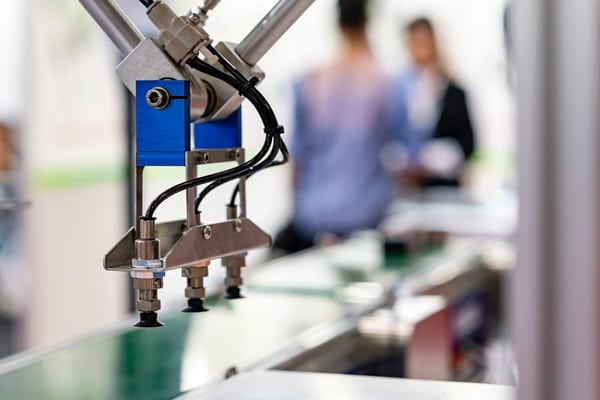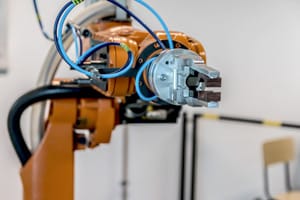Robots have revolutionized the manufacturing process, providing an efficient and cost-effective means to keep humans from having to perform unsafe and repetitive tasks that can cause strain injuries. Pick and place applications are one of the most common places within the assembly process where automation and robots are utilized. While this means factories can easily source suitable pick and place robot models, choosing the right one for a specific applications takes some investigation.
For What Are Pick and Place Robots Used?

Before looking at the exact type of robot to buy, it is best to first look at the functions for which it will be used. Perhaps a robot is needed to perform a specific task, or perhaps a manufacturer requires a more versatile robot that can be easily customized for several purposes. Applications for which these robots can be used are many and varied, and can include bin picking, inspection and even packaging products.
Here are just a few common uses for pick and pack robots:
- Assembly: When used for assembly applications, pick and place robots can pick up incoming components, joining them onto other parts of the workpiece before conveying them to the next assembly point.
- Bin picking: Often assembly lines involve picking components from bins and placing them in other locations for assembly or packaging. Specially designed pick and pack robots with cutting-edge visual sensors combined with AI software can identify colors, sizes and shapes.
- Inspections: In order to inspect for defects, pick and place robots require advanced AI with vision systems to recognize flaws and remove substandard components or products, picking them up and setting them aside in specified bins or areas.
- Packaging: Automation in packing applications involves a robot either placing the finished product into its packaging or, with specifically designed pick and pack robots, placing boxed items on pallets for shipping.

Kinds of Pick and Place Robots
Typically affixed to stable stands and positioned so that they reach specific work areas, pick and place robots use advanced vision and tooling systems configured for different applications. These are often supported by AI software that uses ML algorithms to enable pick and pack robots to “learn” so that it can perform a variety of tasks.
Robotic Arm

Cartesian Robot
Similar to the 6-axis robotic arm, Cartesian robots can work along multiple planes. Named after René Descartes, a French mathematician born at the end of the 16th century, these pick and place robots move across a Cartesian plane using the horizontal X and vertical Y axes, with the Z denoted in the 19th century Cartesian coordinate system used to describe three-dimensional space. These use linear actuators and different types of drive mechanisms. Typically, they offer better positioning accuracy than 6-axis robotic arms.
Delta (or Parallel) Robot
Often used for high-speed food processing, delta robots apply advanced optical technology to differentiate colors, shapes and sizes. Using heavy motors attached to frames, these pick and pack robots come in numerous configurations, though most operate on four axes. To facilitate movement, they use three lightweight arms connected to rods that link joints at opposite ends of each arm.
Fast Pick-and-Place Robot
Ideal for environments that require medium to high volume throughputs, these fast-picking-and-placing robots create a fully automated picking process, where human workers can instead focus on other activities within the manufacturing process. With the quickest able to cycle at up to 150 times per minute, these pick and pack robots are often used in sections of packing lines where promotional or added orders are placed into packaging, such as when including batteries or promotional items.
Cobot (or Collaborative Robot)
Called collaborative robots due their ability to work alongside human workers in separate but compatible tasks, cobots augment human labor by leading workers to picking positions and guiding them through specific tasks. They help optimize the time it takes to complete each action, helping create a more productive fabrication process.
Palletizing Robots
One specific process at which pick and place robots can work involves the palletizing of packaged items to ready them for shipment. Sometimes the throughput from production gets slowed down due to the time it takes to put finished and packed products onto pallets. Though other types of automation are already available for palletizing, they tend to take up a lot of space and cannot adjust readily to varied palletizing jobs. Though not specifically a pick and place process, palletizing is an extension of it, and customized pick and pack robots can easily conduct such operations.
Choosing the Best Pick and Place Robot
With the ability of each type of pick and pack robot to effectively and efficiently execute numerous types of tasks within the manufacturing process, the real challenge is to select the one with configurations that best suit the factory’s operational needs.
Here are a few other considerations:
Number of axes determines how freely the pick and place robot can move, with the more axes generally indicative of greater flexibility.
Recommendations:
-
- 4-5 axes for order fulfillment applications that involve placing items upon a conveyor, bin or container.
-
- 6+ axes for applications that require greater range of motion for the robot to rotate or move linearly.
Payload refers to the maximum load a pick and pack robot can transfer from one point to another, and includes the weight of its tooling.
Recommendations:
-
- At minimum, should be able to lift the heaviest item in a factory’s inventory with its arm fully extended, then place it precisely.
Reach involves looking at a robot’s range of motion to determine the maximum vertical and horizontal distances within the pick and place robot’s grasp. As this requires precision, it is imperative to determine these measurements prior to purchasing.
Recommendations:
-
- Measure vertical reach from the lowest point the robot can reach to the maximum height of its “wrist”.
-
- Measure horizontal reach from the center of the robot’s base to the furthest point its gripper or arm tool can stretch.
Repeatability refers to the pick and place robot’s ability to pick up and drop workpieces precisely within each sequence it completes.
Recommendation:
-
- Actions needing greater precision, like circuit board fabrication, require robots that can repeat movements accurately to under half a millimeter (under two hundredths of an inch), depending on the procedure.
Speed at which a robot can work will affect the efficiency and productivity of the entire manufacturing process, so it is important to evaluate a robot’s specifications to ensure it can keep up with workflow.
Recommendations:
-
- Make sure that the pick and place robot is capable of performing at least at the speed at which the production line operates.
- Look at peak demand periods to ensure it can meet these higher demands.
Additionally, the configurations around which a pick and pack robot can be customized will restrict flexibility due to the robot’s dimensions, shape of tooling and how they are designed to move.
For example, basic pick and place robot configurations include:
- Articulated or SCARA (Selective Compliance Articulated Robot Arm) robots with fixed rotary arms that allow greater degrees of freedom on axes.
- Cylindrical robots that allow movement along horizontal, rotational and vertical axes.
- Spherical robots that allow a single linear and two rotational movements.
These characteristics affect where they can be deployed and the items they can handle. Along with these considerations, the visual guidance system must be sophisticated enough to identify various items along the production line.
